#1824 election
Photo

This quote is widely attributed to John Quincy Adams, though I haven’t been able to find the source. It’s probably the most ironic quote on the subject of voting ever, considering the circumstances of the 1824 election and how he became president.
That year there were four candidates for president:
Andrew Jackson, a former US Army general who had served in both houses of Congress.
John Quincy Adams, a former ambassador and Senator, and the current Secretary of State. He was also the son of John Adams, the second POTUS.
William Crawford, a former Senator, Secretary of War, and the Current Secretary of the Treasury.
Henry Clay, a seven term Congressman who had been elected Speaker of the House during his first term.
Two other candidates, Smith Thompson and John C. Calhoun withdrew before the election.
At the time, the candidates needed 131 electoral college votes to win. Clay carried three states and received 37 electoral votes. Crawford carried two states and received 41 electoral votes. Adams carried seven states with 84 electoral votes, and Jackson carried twelve states with 99 electoral votes. Jackson was also the winner of the popular vote. But none of the four candidates won enough electoral votes to win the presidency.
As prescribed by the 12th Amendment, the election then moved to the House of Representatives, voting by state delegation with one vote per state. Choosing among the top three candidates, the delegations of thirteen of the 24 states in the union voted for Adams.
A year later, a constitutional amendment was being considered to either abolish or modify the electoral college.
#quote#John Quincy Adams#1824 election#electoral college#Andrew Jackson#William Crawford#Henry Clay#US House of Representatives#12th Amendment
7 notes
·
View notes
Text
Chasing Shadows: The Illusion of the American Dream
Photo by Pittigrilli on Wikimedia Commons
The realization that the country I was raised to love was a lie didn’t happen because of one particular event. It wasn’t even a single string of events. Equality and freedom for all never had and never could exist because of corrupt foundations. The American Dream has remained just that, an ethereal mist blown over a sleeping populace.
It was all…

View On WordPress
#1787 Constitutional Convention#1920 election#Alexander Hamilton#American dream#American myth#American Politics#anarchism#capitalism#Christopher Columbus#Compromise of 1877#corruption#Don&039;t Ask Don&039;t Tell#election of 1824#ethnic cleansing#exposing lies#founding fathers#genocide#Gerald Ford#Indigenous peoples#inequality#injustice#LGBTQIA+ oppression#Native Americans#oppression#racism#Republican#Richard Nixon#Rutherford B. Hayes#slave trade#slavery
1 note
·
View note
Text
Clivesdale and Hatchetfield are the same town
This is how Hatchetfield is shown in the first trailer for The Guy Who Didn't Like Musicals:

Notice how nearly all of the buildings appear twice, with a mirrored version on the other side of the picture. This reminds me of this shot in the Workin' Boys trailer, and I started to wonder if it meant that Hatchetfield had a parallel alternate reality mirror dimension:

What if that dimension is Clivesdale? It would explain why some things in Hatchetfield have direct Clivesdale counterparts (Hatchetfield's Dan and Donna and Clivesdale's Rachel and Rod, Hatchetfield's honey festival and Clivesdale's cherry festival). It would also explain how people almost never leave Hatchetfield, except to go to Clivesdale.
Plus, the name "Clivesdale" is comprised of "Clive", meaning cliff, and "Dale", meaning valley. This reminds me of Hill Valley from the Back to the Future series, a town which many alternate versions of are shown throughout the series.
Two more details I noticed from the initial TGWDLM trailer, in case anyone doesn't think they were already thinking about and hinting at lore when TGWDLM was first announced:
-The narrator mentions that Paul thinks Alexander Hamilton was America's 6th president. The 6th U.S. president was actually John Quincy Adams, who was elected in 1824, the same year Hatchetfield was founded!
-Nick Lang films himself in front of this photo:

The choice of which is interesting for a few reasons:
1. Sam Raimi, who directed the Tobey Maguire Spider-Man movies is one of Nick Lang's inspirations/influences in writing Hatchetfield
2. The visual foreshadows Paul being "split in two" during Let It Out (and maybe also the two towns if this theory is correct)
3. Spidey Sense is reminiscent of the Gift, hinting that some citizens of Hatchetfield will have psychic powers
#starkid#hatchetfield#tgwdlm#nightmare time#nmt2#workin boys#the witch in the web#honey queen#back to the future#horror#comedy#musical#theory
141 notes
·
View notes
Note
How many presidential rematches have there been?
When it comes to the major candidates in a general election, this year's election will be the ninth rematch:
•John Adams vs. Thomas Jefferson: 1796 & 1800
•John Quincy Adams vs. Andrew Jackson: 1824 & 1828
(William H. Crawford and Henry Clay were also candidates in 1824)
•Andrew Jackson vs. Henry Clay: 1824 & 1832
(John Quincy Adams and William H. Crawford were also candidates in 1824; John Floyd and William Wirt were also candidates in 1832)
•Martin Van Buren vs. William Henry Harrison: 1836 & 1840
(Hugh L. White, Daniel Webster, and Willie P. Mangum were also candidates in 1836)
•Grover Cleveland vs. Benjamin Harrison: 1888 & 1892
(James B. Weaver was also a candidate in 1892)
•William McKinley vs. William Jennings Bryan: 1896 & 1900
•Dwight D. Eisenhower vs. Adlai E. Stevenson: 1952 & 1956
•Bill Clinton vs. Ross Perot: 1992 & 1996
(George H.W. Bush was also a candidate in 1992; Bob Dole was also a candidate in 1996)
•Joe Biden vs. Donald Trump: 2020 & 2024
#History#Presidents#Presidential Elections#Presidential Candidates#Presidential Nominees#Presidential Rematches#Elections#Campaigns#Presidential Campaigns#Presidency#Presidential History#Election Rematches#John Adams#President Adams#Thomas Jefferson#President Jefferson#John Quincy Adams#JQA#Andrew Jackson#President Jackson#Henry Clay#William Henry Harrison#President Harrison#Martin Van Buren#President Van Buren#Grover Cleveland#President Cleveland#Benjamin Harrison#William McKinley#President McKinley
25 notes
·
View notes
Text
Boris Ivanovich Orlovsky, 1790/1837
The Shepherd Paris, 1824, marble from 1838, last work by Orlovsky.

Trojan prince, son of Priam, he wears the Phrigian cap of the Trojans. Abandoned at birth and taken in by shepherds, he holds the shepherd's staff in his left hand,

and in his right hand the golden apple,

Apple of discord", intended "for the most beautiful of the goddesses of Olympus" whom he must choose between, Athena, Hera and Aphrodite elect, who promises him love of the most beautiful Greek woman.
Which starts the Trojan War...

Born into a family of serf peasants in Tula, Russia, his artistic talent led Boris Ivanovich Orlovsky to be freed by his master who sent him to the Imperial Academy of Arts in Saint Petersburg.
14 notes
·
View notes
Text
The Bicentennial: The Response and Trouble at home
In Paris on May 10, 1824 La Fayette wrote a letter in response to the invitation by the Congress of the United States to return to America for an Triumphant Tour.

Here is a full transcript of the letter by Hampton Kennedy for James Monroe’s Highland:
Paris, May 10, 1824
Sir
The high favour confered upon me By the Representatives of the people of the United States, the testimonies of public Benevolence Contained in their Resolution Have filled my Heart with feelings of Respectful, Affectionate, and patriotic Gratitude which I want Adequate Words to Express. No Answer Can I find more Congenial to those feelings than to Embark as Soon as possible for the Beloved Shores I Have for so many Years longed to Revisit. Nor Can I fear, impressed as I am With a proud Sense of the Honour to Be on Board a National Ship, that it Will appear insincere on My part When I Beg leave no to Avail myself of the flattering offer which, in their Extreme Kindness, Congress Have deigned to Bestow. The Summer Will not Be over Before I enjoy the delight to find myself, Under an American flag, on my Way to the Beloved land of which it has Been My Happy Lot to Become an early soldier and an Adopted Son.
Be pleased, Sir, to receive my Affectionate and Grateful Respects.
Lafayette
‘Monroe and Lafayette’ (no date) Highland. Available at: https://highland.org/teacher-resources/monroe-and-lafayette/ (05/10/2024).
On October 30, 1818, La Fayette became a member of the Chambre des députés for the department Sarth. He failed to be elected for Seine-de-Marne, the department of his beloved La Grange where he lived when not in Paris. In 1824, shortly before being invited to America, he lost his re-election for his seat in the Chambre and felt defeated – he was defeated. The invitation to America came at the perfect timing - all this besides his personal feelings.
#marquis de lafayette#la fayette#lafayette#history#french history#american history#1824#james monroe#letter#handwriting#on this day in history#otd#the bicentannial#tour of 1824/1825
11 notes
·
View notes
Note
Who do you consider to have been some of the most important / formative mayors of New York?
This is a great question, and actually rather difficult to answer, because for the longest time both Tammany Hall and the Whig/Republican machine tended to prefer mayors who were dull but reliable non-entities. Starting in 1824, NYC was divided into wards that elected Aldermen and Assistant Aldermen to the Board of Aldermen and the Board of Assistants, who together made up the bicameral Common Council. This led to a system whereby the real political action was shunted to the local level, where the ward's Aldermen and the ward boss (and his precinct bosses) ran the show.

The downfall of Boss Tweed led to some reforms, with the bicameral Common Council replaced by a unicameral Board of Aldermen who were elected from larger State Senate districts or at-large, as part of the Whig Party's drive to dilute the power of Tammany's Irish Catholic voting base. This would change somewhat when the five boroughs were consolidated into Greater New York in 1898, which added the borough presidents and the Board of Estimate into the mix, and then again in 1901 and so forth.
However, the overall trend was a weak mayor system where real political power was fairly evenly distributed between aldermen (who were not only the city's legislatures but were also represented on the Board of Estimate through their President), the borough presidents, the mayor, and the comptroller.
So the major players in NYC politics tended not to be mayors:

Dewitt Clinton was incredibly transformational, but despite serving three terms as mayor his real mark on New York was as governor where he was the driving force behind the construction of the Erie Canal.
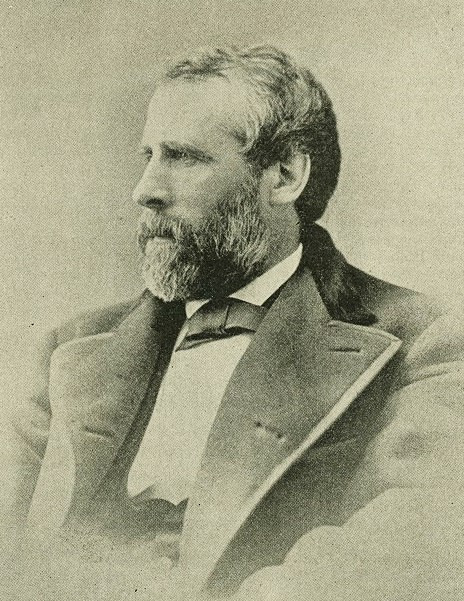
Andrew Haswell Green, the "Father of Greater New York," was responsible for the creation of Central Park, the New York Public Library, the Bronx Zoo, The Museum of Natural History, the Metropolitan Museum of Art, Riverside, Morningside, and Fort Washington Parks, Columbus Circle, and the consolidation of Greater New York - but he never served as mayor. The original Robert Moses, Green's political power came from his leadership of the Central Park Commission, the Greater New York Commission, a six-year stint in the Comptroller's office, and his position on a number of NGOs.
But if we're talking transformative mayors, there is one name that rises above all the rest: Fiorello goddamn LaGuardia.

There had been other reform mayors before him - Seth Low had established the Civil Service, John P. Mitchel brought scientific management to city government - but none of them had ever been able to get re-elected. Unlike the wealthy WASP reformers, LaGuardia knew how to beat Tammany at the ethnic politics game. Tammany's strength had always been in the Irish wards of the city, and while they had tried to divide-and-rule by promoting the naturalization of Russian and Polish Jews in return for them voting for Irish-American politicians in the Lower East Side while noticably neglecting the naturalization of Italians, the emergence of second-generation Jewish and Italian voters meant that this strategy had run its course.
Born to a Sephardic mother from Trieste and a lapsed Catholic father from southern Italy, Fiorello had an astonishing knack for transcending ethnic political boundaries in New York City - he spoke Italian, German, Yiddish, and Croatian, but he was also a progressive Republican and Episcopalian (which meant he could speak middle-class WASP too). LaGuardia won the 1933 mayoral election by bringing together a Fusion coalition that brought middle class German-American Republicans together with Italians and Jews, a coalition that he would expand in 1936 by bringing socialists, unions, and black voters together into the American Labor Party.
Over his twelve years as Mayor, LaGuardia was almost pathologically active (in a way that's oddly reminiscent of Henry II), transforming almost every aspect of New York City:
Jobs for the Unemployed:
LaGuardia's immediate mission as mayor was to fight the Great Depression that had had left a third of the City unemployed. He did this by forming an enduring alliance with FDR in which the New Deal would provide NYC with unpredecented level of federal support in exchange for NYC becoming the New Deal's model city - the first of the "Little New Deals." In his first hundred days in office, LaGuardia convinced FDR to give New York City a full 20% of the Civil Works Administration's work relief budget. This put 200,000 New Yorkers back to work - and this would only be the beginning of New York City's experiments with direct job creation.
As part of Fiorello LaGuardia's "Little New Deal," LaGuardia's new Parks Department employed 70,000 workers - paid for by CWA and later WPA money - to rebuild New York City's parks, constructing the Central Park Zoo and 60 playgrounds in the first year.
When the New Deal created the Works Progress Administration in 1935, LaGuardia once again lobbied FDR to put NYC first in line. This culminated in some 700,000 New Yorkers - a tenth of the city's entire population - getting jobs through the WPA and other New Deal programs. Together with the Parks Department, LaGuardia and Robert Moses would mobilize this workforce to completely transform the city.
Public Works:
This is where we have to discuss Fiorello LaGuardia's fateful decision to make Robert Moses his master builder. While Moses was in the process of becoming the "Power Broker" before LaGuardia - he had already been made president of the Long Island State Park Commission and chairman of the New York State Council of Parks - LaGuardia enabled his ascent to the heights of power by making him Parks Commissioner, Commissioner and then Chairman of the Triborough Bridge Authority, Commissioner of the NYC Planning Commission, and Chairman of the Emergency Public Works Commission.
The pact between them was simple: LaGuardia would give Moses the public appointments he needed to consolidate public works across the city and would steer New Deal public works money through Moses' agencies, and in exchange Moses would be LaGuardia's master builder with a mandate to "build it quickly and build it well." This was not an easy task, because Robert Moses was a political enemy of FDR and FDR tried to bar him from being given any WPA or PWA funding, but the mayor was able to persuade Roosevelt that it was more important that LaGuardia's proposed $1 billion public works program for NYC be carried at speed and administered efficiently.
As LaGuardia's workhorse, Moses would oversee almost all of NYC's public works, including the West Side Highway, the future FDR Drive, the Brooklyn Battery Tunnel, the Triborough Bridge, the LaGuardia and future JFK Airports, and Jones Beach Park, among others. LaGuardia would also construct the Sixth Avenue Subway line, the Queens-Midtown Tunnel and the Lincoln Tunnel without Moses (who was completely uninterested in mass transit and who always preferred bridges to tunnels).
In addition to these major projects, LaGuardia with and without Moses built the city's first municipal power plants, 37 sewage treatment plants, 9 fire houses, 142 elementary schools and 22 high schools, half of NYC's then-23 municipal hospitals, eight District Health Centers to provide preventative, specialized, and public health immunization care, and the first 14 of the City's public housing projects.
City Government:
To dismantle Tammany's patronage system, he began to massively expand the civil service to eliminate patronage jobs, and then when Tammany beat him on a government reform bill in 1934, he simply kept pushing. He pushed through the LaGuardia Reform Charter of 1938 that abolished the Tammany-dominated Board of Aldermen and replaced it with a City Council elected by Single Transferrable Vote, established the Board of Estimate as a central administrative body with powers over the city budget, public contracts, franchises, and land use - crippling Tammany's ability to raise money through graft and kickbacks.
To transform New York City into a "strong mayor" model, he undertook a campaign of transforming independent agencies scattered across the five boroughs into a system of unified citywide departments or public authorities that answered directly to the mayor and gave him unprecedented state capacity. In 1934, he formed the Parks Department and the New York City Housing Authority; in 1936 he formed the Department of Buildings and the City Planning Commission; in 1938, he restructured the Department of Welfare to run the city's social welfare programs and a massively expanded public hospital system; in 1940, he took over the IRT (operating the 1, 2, 3, 4, 5, 6), and the BMT and IND (operating the A, B, C, D, E, F, G, J, L, M, N, Q, R, W, and Z lines), unifying the NYC subway system for the first time.
To deal with police corruption, LaGuardia appointed Lewis Valentine to purge the NYPD so that the mayor could use it (and Thomas Dewey) in a crusade against the mafia's gambling, racketeering, and vice operations. This marked a rare period of honesty and effectiveness in the NYPD, although after WWII the system of protection rackets and mafia corruption would eventually re-establish itself.
Ironically, this exhaustive list of accomplishments really made it hard for later mayors to distinguish themselves, because mostly their task was completing, managing, or mis-managing the system that LaGuardia had built. After LaGuardia I would say that Robert Wagner Jr. (established public sector collective bargaining, created CUNY, Lincoln Center, Shakespeare in the Park, and dealt the killing blow to Tammany) and John Lindsay (see my previous post, but chiefly scatter-site housing, the civilian complaint review board, and the Knapp Commission on police corruption) are on my list of formative mayors.
After them, there have been long-serving mayors and good mayors, but unfortunately not the two combined.
#history#historical analysis#nyc history#nyc mayor#fiorello laguardia#tammany hall#urban history#urban studies#urban politics#political machines#new deal#robert moses#infrastructure
28 notes
·
View notes
Text
i want to list some seward stories here so people can understand a little better why i like this little fucker. here’s what i call “sewardisms”:
so william henry seward was THE light of the ballroom basically. he was ur one stop to have a good conversation with a cigar and drink in hand. and imagine that while knowing he was a fiery little red head standing at 5’6 who’s slender frame was likened to a scarecrow.
his favorite color was yellow and YOU WILL KNOW it. half of his clothes were yellow. his hanker-chiefs were yellow. He loved himself some stupid yellow.
he married frances seward in 1824 and they were the cutest lovebirds ever. they had five kids and fred seward and his wife became the like Defacto secretaries of seward and his lafayette park house bc he was literally never at home with his wife.
continuing w him and frances he once got into a love triangle (square?) with frances and this older senator who saw him as a young man who could fulfill his dreams. his name was albert tracy haller and this is one of his letters to him:
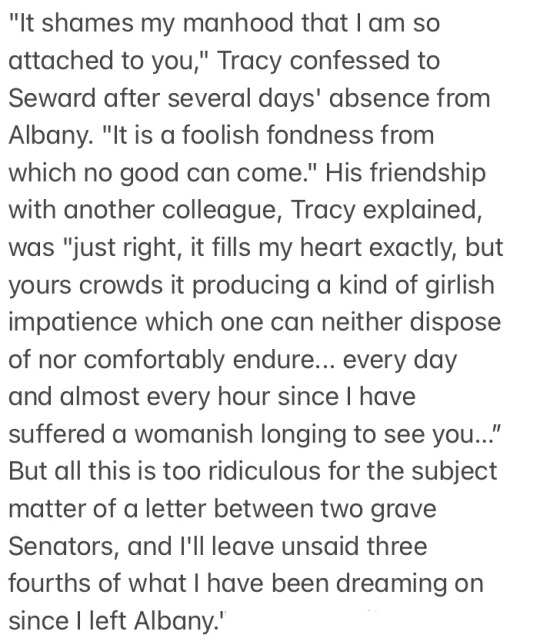
SO seward replies reciprocating it stating that he was happy learning they shared “feelings which I had become half ashamed for their effeminacy to confess I possessed.” but then haller gets like more continually obsessive and angry when seward doesn’t respond as quickly (he’s just like me fr). so he ruined their relationship as haller and thurlow weed (sewards bff and main political advisor) were ALSO beginning to beef over seward. so seward ended up picking weed over the obsessive haller. BUT ITS NOT OVER!!! because while seward is off working haller gets in with frances and tries to get with her and it starts to work… until seward writes a bunch of letters crying and begging her to not leave him because he was scared she didn’t love him anymore. so they both decided to throw haller out and never speak to him again! Power couple!!!
the first night that abraham lincoln and seward met they had to share a bed together where they chatted throughout the night and then finally fell asleep. in a weird coincidence, and the final days they spent together were in seward’s bed as he whispered stories to seward who was currently in excruciating pain because of his shoulder and broken jaw. whenever seward finally fell asleep (something which he dearly needed) lincoln finally left.
i just absolutely adore the relationship between the two. they started off as aquantiances and grew into rivals during the 1860 election. whenever lincoln won seward was PISSED that such a lowly small town lawyer could win but took the secretary of state job anyways. they slowly grew into friends and then by the end of the first year lincoln was spending basically every waking moment with him. they had the same sense of humor and interests, such as theater which seward was his main guest at each performance. they were basically inseparable as he was the closest to lincoln in the cabinet and they had become bffs. they make me so happy, they didn’t care for looks and most of the time you could find them with ruffled hair and misplaced clothing. seward thought the absolute world of lincoln because of how good of a person he was. like i just can’t understate how much seward loved lincoln and saw him for all of his wisdom. i’ve mentioned this before but at this point seward was seeing lincoln more than lincoln’s own wife so she (being mary todd) was angry and jealous of seward (totally understandable) who lincoln spent his nights with instead of her. this jealousy also leached out into other members of the cabinet such as salmon p chase, edwin stanton, and gideon welles who were angry their president spent more time with seward than the actual cabinet. they thought seward had his ear most of the time and was just the acting president. ppl spread those rumors a lot my favorite insult is when george mcclellan called seward a meddling incompetent puppy. it got to the point where seward was gonna resign bc of it until lincoln stepped in and was like No you’re not leaving.
seward came up with adding thanksgiving as a holiday and lincoln was like “hell yeah”
seward got into a carriage accident and dislocated his shoulder and broke his jaw. so for a few weeks he was bed ridden. during this time was the assassination attempts of both him and lincoln. lincoln died while seward’s face was slashed the hell up but he was otherwise still kicking. no one told him that lincoln had passed but when he saw the american flag hanging half mast one morning he knew. while crying he said that if lincoln was alive he would have already come to see him or ask about him but he knew.
after this was some more big hits as his wife died the same year and so did his daughter. he was literally having the WORST year ever and i feel so bad for him.
yeah there’s definitely more but those are the big bits (which i’m probably fucking up some). he’s so campy. i love the little fucker so so much.
#william seward#william h seward#abraham lincoln#american civil war#acw#this is just a place to let me ramble about possibly well-known shit#BUT I DONT CARE!!
17 notes
·
View notes
Text
Speaking of Presidential elections that were super weird, because America's electoral system is just a total mess and always has been-
1824.
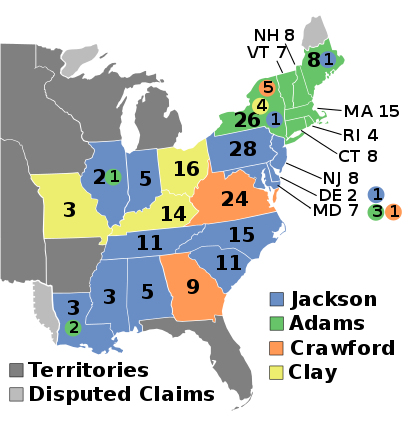

Ok. So. Looking at those numbers, the popular vote, the electoral vote, who do you think became president in 1824?
Did you guess *John Quincy Adams*, the guy who came in second for the popular vote AND second in electoral votes? Hahahahahaaaaaaaaa
See, no one got the 51% of the electoral votes you need to win. Doesn't matter that Jackson had a plurality- he needed a MAJORITY. So because there was no majority, CONGRESS got to vote and Congress can vote however they want.
So Clay here gets eliminated, and Congress gets to vote from the top three. Now because of...reasons in the 12th amendment, how this breaks down is all the reps from a state come together and get 1 vote. 1 vote per state in Congress.
Now, Clay (who had been eliminated) *hated* Jackson (which, yeah, fuck Jackson.) He had the closest politics to Quincy Adams, so he goes around and tells all the states where he had won a plurality to give their votes to Adams. The Kentucky delegates also just go rogue (they had been ordered by their state government to vote for Jackson, and they just...didnt)
So in the end, despite getting trashed in the popular vote and the electoral college, Quincy Adams was able to get the most *individual states* on board.
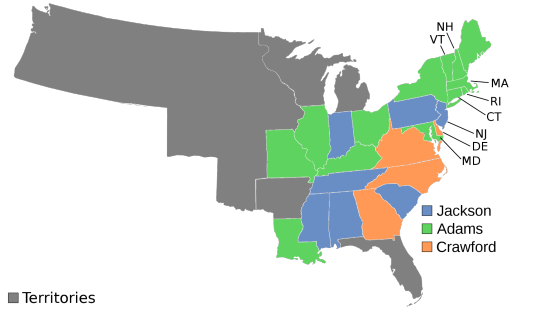
And becomes the 6th president with 30% of the popular vote- the only president to ever win without actually winning the electoral college.
(Jackson, the fucker, would absolutely beat his ass in 1828.)
(Fun fact, Quincy Adams holds the record for lowest popular vote for a winner. 2nd place goes to Lincoln, who scrapped out 40% of the popular vote all while *not even getting put on the ballot* in most of the South.)
But uh. Yeah. We had this chunk of time in the 1800s where we legitimacy had like 3 or 4 viable parties/candidates in each election and it kept causing weird elections. Which is WHY I think that a pure popular vote isn't the ideal solution (just better than the EC)- Ranked Choice voting is actually a much stronger option.
318 notes
·
View notes
Text
John Hanson
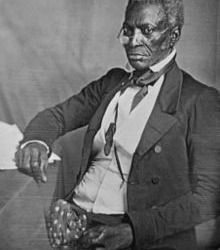
John Hanson was a Liberian senator during the mid-19th century who has been erroneously claimed as the first Black president of the United States. Not much is known about Hanson’s early life. He was born into slavery in Baltimore, Maryland, around 1791. According to some historians, Hanson purchased his freedom but the method and year are unknown.
In 1816 the American Colonization Society (ACS) was formed in Washington, D.C., with the purpose of sending former enslaved people to a colony in West Africa. In 1822 the ACS established that colony. That year two members of the Society purchased land for the colony at Cape Mesurado, on the west coast of Africa. The new colony was named Liberia in 1824 and the first Black settlers in Liberia named the city they founded, Monrovia, after then U.S. President James Monroe.
Hanson emigrated to Liberia in 1827 through the Society and quickly became a member of the mercantile and political elite formed by these former slaves. The ACS, which controlled the colony until its independence in 1847, organized the Commonwealth of Liberia in 1839 and appointed its first governor, Thomas Buchanan. Hanson was elected as a senator of the newly established Colonial Council in December 1840, representing Grand Bassa County. John Hanson died in Liberia in 1860 at the age of 69. After his death, Hanson was hailed as a faithful, loyal, and patriotic servant of the young nation, only the second Western-style republic (after Haiti) in the world at that time, by Stephen Allen Benson, then president of Liberia.
False information about Hanson as the first Black president of the United States had already been circulating long before the internet. The new media, however, spread that information much farther and much faster than ever before. Hanson was often confused with a white politician of the same name, who was falsely claimed to be the first president of the United States. in 1781, this other man was named president of Congress under the Articles of Confederation before the U.S. Constitution officially established the office of president of the United States. Because of his position as president of the Congress, some have erroneously argued that he, not George Washington, was the actual first president. Adding to the confusion was the fact that Hanson has been thought to be the dark-skinned man on the back of the $2 bill. The image on the $2 bill shows the drafting of The Declaration of Independence by painter John Turnbull. The image some claimed as Hanson is actually Robert Morris, one of the original signers of the Declaration. Morris’s image appears dark on the bill due to the type of printing used then.
https://www.blackpast.org/african-american-history/people-african-american-history/john-hanson-1791-1860/
14 notes
·
View notes
Text
SET FIFTEEN - ROUND TWO - MATCH FOUR


"Lágrimas De Sangre (Tears of Blood)" (1973 - Oswaldo Guayasamin) / "Boy Staring at an Apparition" (1824–25 - Francisco Goya)
LÁGRIMAS DE SANGRE (TEARS OF BLOOD): although this video will do a much much better way of explaining the painting -> https://www.youtube.com/watch?v=708VY9l-Ids here's the summary -> in 1973, after the coup d'état in Chile replacing the democratically elected president Salvador Allende for the military dictator Augusto Pinochet, Oswaldo Guayasamin, an Ecuadorian artist painting a horrifying picture of United States Imperialism: Lagrimas de Sangre. please please give the video a watch, it's around 12 minutes long and it just guts you out i specifically love the way he was able to convey genuine terror through his art piece. (anonymous)
BOY STARING AT AN APPARITION: [no additional commentary] (anonymous)
"Lágrimas De Sangre (Tears of Blood)" is an oil on canvas painting by Ecuadorian artist Oswaldo Guayasamin. It measures 55 1/10 × 39 2/5 in (140 × 100 cm) and is probably held by Fundación Guayasamín, Quito.
"Boy Staring at an Apparition" is a piece done with a carbon black wash, with watercolor and scratching, on ivory. It is by Francisco Goya, and is the smallest piece in the tournament at 5.9 x 6 cm (2 5/16 x 2 3/8 in.). It is held by the Museum of Fine Arts, Boston and is not currently on display.)
#art that fucks you up tournament#polls#atfyu polls#id in alt text#cw eye contact#cw horror#unreality
35 notes
·
View notes
Text

was watching a youtube on the 1824 US election and this image jumpscared me
ABSOLUTELY THREW ME
i know
i know its supposed to show their animosity
but this is ✨gay✨propaganda
#this isnt even about the corrupt bargain im pretty sure#still it gave me a stroke seeing it#symptoms of a locked jaw :v#political cartoons have so much material to work with in them omg#gives WHUMP IDEAS FHDGFHDGFHDGFHDF#clay gets a needle...#andrew jackson#henry clay#im such a normal person..
7 notes
·
View notes
Photo
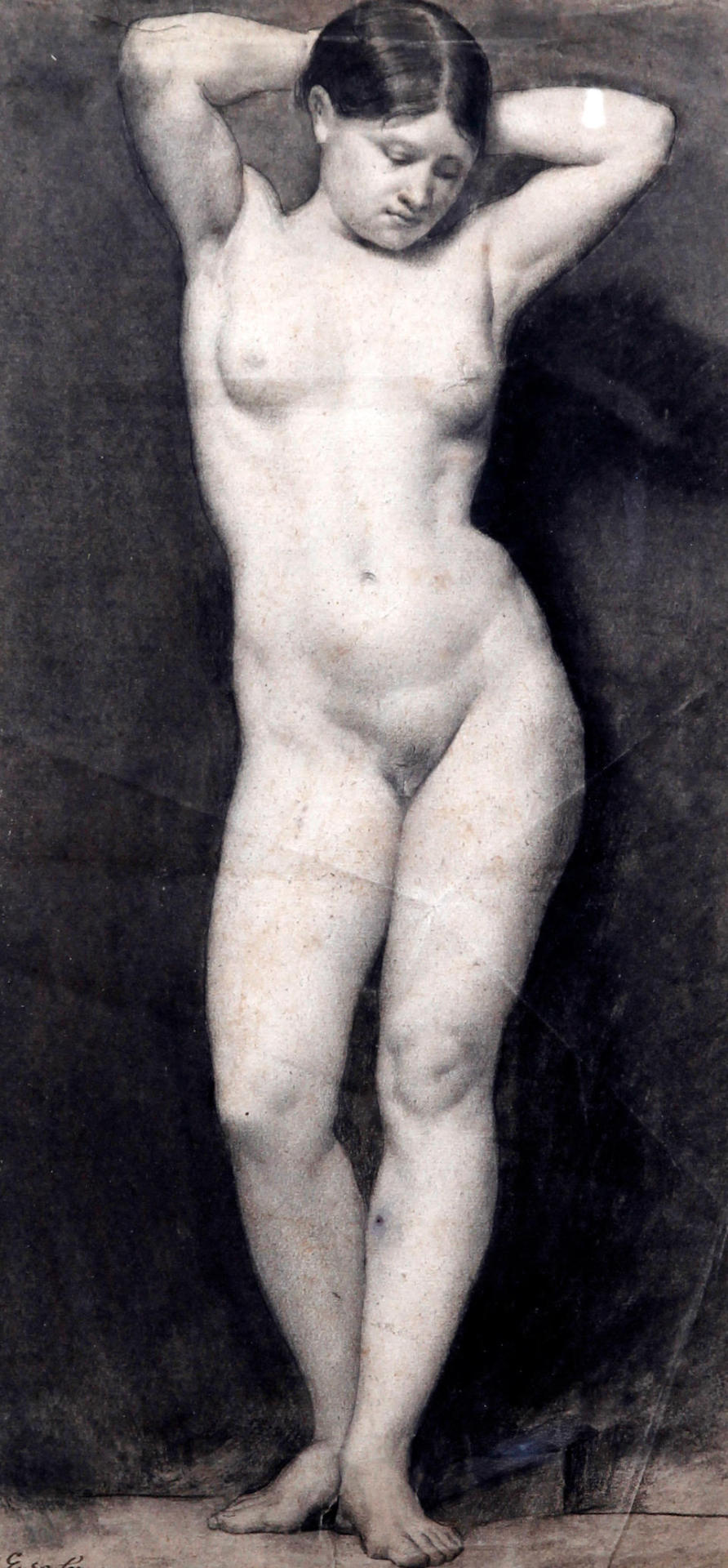
Eyre Crowe ARA (1824-1910) British
Life drawing of a standing female nude 1846
He exhibited paintings at the Royal Academy in London between 1846 and 1908. In 1876 he was elected an Associate of the Royal Academy.
60 notes
·
View notes
Text
The End of the "Era of Good Feelings": Monroe vs. Crawford

James Monroe, 5th President of the United States, led the nation during the “Era of Good Feelings” (1817-1825) when partisan rancor was so diminished that Monroe ran unopposed for re-election in 1820 and was just one vote short of an unanimous Electoral College victory.
The “Era of Good Feelings” collapsed and fell right into regular American partisan bitterness with the 1824 Presidential election, and during that time, the popular President Monroe found some bad feelings in his own Cabinet which resulted in a bizarre confrontation in the White House that winter – the President of the United States vs. the Secretary of the Treasury, no-holds-barred.
Treasury Secretary William H. Crawford had been a front-runner to replace Monroe, but a stroke in 1823 ruined those chances. Crawford had been serving as Secretary of the Treasury since 1816 when he was appointed by President James Madison and continued on throughout Monroe’s term. Tired, frustrated, and ready to retire home to Georgia, Crawford called on Monroe at the White House to suggest a list of appointments he wished the President to approve for custom officers at ports in the Northeastern United States, some of the choicest political patronage positions available in the federal government. However, Monroe objected to Crawford’s list and stated that he intended to name his own picks. Crawford lost his temper and told the President, “Well, if you will not appoint persons well-qualified for the places, tell me whom you will appoint that I may get rid of their importunities!”.
The President – a Revolutionary War veteran of George Washington’s Army who carried a bullet in his body that had nearly killed him in 1776 – was not intimidated by Crawford’s language or temperament, coldly telling his Treasury Secretary, “Sir, that is none of your damn business." Crawford was not easily intimidated, either. The Treasury Secretary had killed a man in a duel years earlier and Monroe’s comment led Crawford to charge at the 67-year-old President with his cane, shaking it at Monroe while calling him a "damned infernal old scoundrel." Monroe quickly grabbed two red hot tongs from a nearby fireplace for self-defense and threatened to personally throw Crawford – who was 15 years younger than the President – out of the White House.
Both men calmed down as President Monroe prepared to summon his servants to show the Treasury Secretary out. Crawford apologized for his actions and stated that he did not intend to insult or threaten the President. Before Monroe could ask him to leave, Crawford left the White House on his own. The two men never spoke again.
The "Era of Good Feelings” was over.
#History#Presidents#James Monroe#President Monroe#Monroe Administration#William H. Crawford#Secretary of the Treasury#Era of Good Feelings#Politics#Political History#White House History#Presidential Rivalries#Political Feuds#Presidential History
16 notes
·
View notes
Text
John Church Hamilton to unknown, New York, [January 12, 1824]
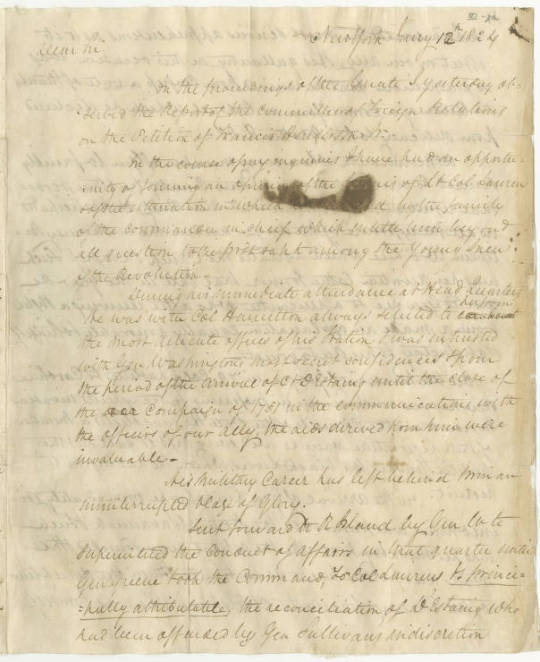
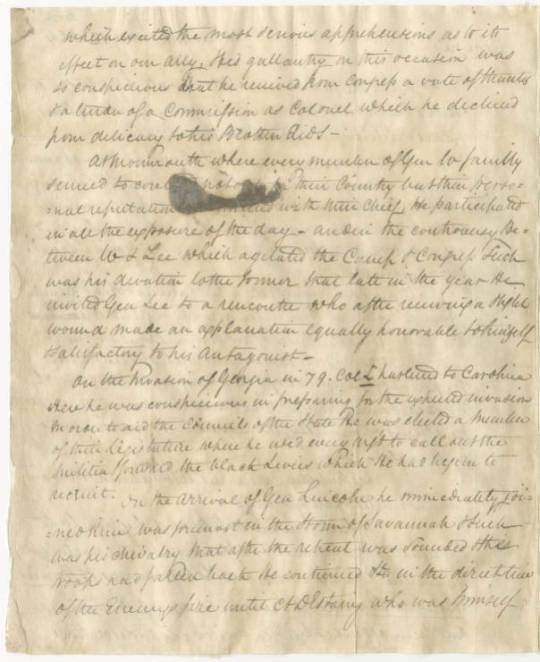
Dear Sir:
In the proceedings of the Senate, I yesterday ob served the Report of the Committee of Foreign Relations on the Petition of Francis Henderson Jr. In the course of my inquiries I have had an opportunity of forming an opinion of the services of Lieut. Col. Laurens and of the estimation in which he was held by the family of the Commander in chief, which entitles him, beyond all question to the first rank among the young men of the revolution. During his immediate attendance at headquarters he was, with Col. Hamilton always selected to perform the most delicate offices of his station, and was entrusted with Gen. Washington's most secret confidences, and, from the period of the arrival of C D'Estaing, until the close of the campaign of 1781, in the communications with the officers of our ally, the aids derived from him were invaluable.
His military career has left behind him an uninterrupted blaze of glory. Sent forward to R Island, by Gen W. to superintend the conduct of affairs in that quarter until Gen. Greene took the command; to Col. Laurens is principally attributed the reconciliation of D'Estaing, who had been offended by Gen. Sullivan's indiscretion, which excited the most serious apprehensions as to its effect on our ally. His gallantry on this occasion was so conspicuous that he received from Congress a vote of thanks and a tender of a commission of Colonel, which he declined from delicacy to his brother aids. At Monmouth where every member of Gen. W's family seemed to contend, not only for their country but for their personal reputation, as connected with their chief, he participated in all the exposure of the day and, in the controversy between W. & Lee which agitated the camp and Congress, such was his devotion to the former that, late in the year, he invited Gen. Lee to a rencontre, who, after receiving a slight wound, made an explanation equally honorable to himself and satisfactory to his antagonist.
On the invasion of Georgia in '79, Co' L. hastened to Carolina. Here he was conspicuous in preparing for the expected invasion. In order to aid the councils of the State, he was elected a member of their Legisla ture where he used every arg to call out the militia and forward the black levies which he had begun to recruit. On the arrival of Gen. Lincoln, he immedi ately joined him; was present in the storm of Savannah, and such was his chivalry, that, after the retreat was sounded, and the troops had fallen back, he continued on, in the direction of the enemy's fire until C D'Es taing, who was himself wounded, pointed him out to Lincoln, who ordered him to draw off a detachment in order to remove him from the field.
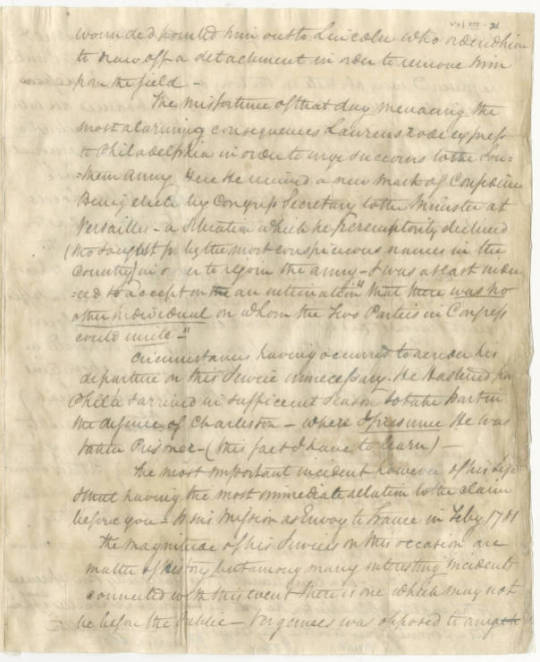

The misfortune of that day menacing the most alarming consequences, Laurens rode express to Philadelphia, in order to urge succours to the Southern Army. Here he received a new mark of confidence; being elected by Congress Secretary to the Minister at Versailles- a situation which he peremptorily declined (though sought for by the most conspicuous names in the country)_ in order to rejoin the army, and was at last induced to accept, on an intimation “that there was no other individual on whom the two parties in congress could unite.” Circumstances having occurred to render his departure on this service unnecessary, he hastened from Philadelphia and arrived in sufficient season to take part in the defence of Charleston, where I presume, he was taken prisoner_ (this fact I have to learn).
The most important incident, however, of his life and that having the most immediate relation to the claim before you, is his mission as Envoy to France in Feby. 1781. The magnitude of his services on this occasion are matters of history, but among many inte resting incidents connected with this event there is one which may not be before the public. Vergennes was opposed to any open interference on our behalf at the outset of the quarrel, and always continued adverse to our independence. In this spirit he presented every obstacle in the way of Col. Laurens negotiation,_ Wearied by these delays L. obtained an interview with him, and after a warm expostulation, characteristic of his noble spirit, he broke from him_ prepared a memorial to the king, and, waiting upon him in the succeeding levée, regardless of the etiquette of the court, handed it to Louis in person. This decisive bearing although it excited great astonishment, was followed by the happiest effects. On the succeeding day the ministers contended with each other in their zeal to promote his views, and he returned here in sufficient season to aid us in a most critical posture of our affairs. (The money obtained by Laurens was deposited in the Bank of N. A. and sustained the financial operations of Mr. Morris until the signature of the provisional treaty). Laurens arrived in Boston, in Sept. 1781, and he immediately joined the army and in the storm of the Redout on the night of the 14th Oct, which was the closing scene of my father's service, L. who, with a body of picked men, was detached by him to take the enemy in reverse and intercept their retreat, entered the works among the foremost and made prisoner the commanding officer. As a compliment to his gallantry and in reference to the capture of Charleston, he with the Viscount De Noailles, was appointed a commissioner to settle the terms of the capitulation.
(Signed)
John C. Hamilton.
44 notes
·
View notes
Note
will you be voting for andrew jackson in the election of 1824
No,
Joey
7 notes
·
View notes